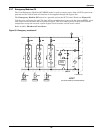
Operation
76
3.3.3 Momentary Overloads
An overload in the critical load will continue to be supplied by the UPS system if the overload condi-
tion does not exceed the current versus time curve of overload capacity for either the SCC rating or for
the number of modules on-line.
For momentary overloads exceeding 155% of rated system (SCC) current, the static switch turns on
for 40 milliseconds to provide current from the bypass line in parallel with current from the UPS sys-
tem output. Up to 1000% of rated current can be supplied for less than one cycle, while up to 500% of
rated load can be sustained for the full 40 milliseconds of pulsed-parallel operation. By providing two
power sources simultaneously, high current can be supplied to the critical load with full output volt-
age regulation. The critical load can be supported through inrush currents and momentary faults
without operating the motorized circuit breakers. Pulse paralleling also serves, under some circum-
stances, as a backup in the event that an external bypass feeder breaker (e.g., BFB) trips open during
this pulse-paralleling period, retaining the UPS inverter connection with the critical load.
If an overload condition exceeds 40 milliseconds, the UPS system continues to supply power to the
critical load if it remains within the current-versus-time curve of overload capacity. If the system
overload capacity is exceeded, the UPS control logic at the SCC initiates an automatic transfer to the
bypass line by operating the static bypass switch and the motorized system circuit breakers (SBB and
UPS Output). Refer to 3.5 - Automatic Operations.
Figure 55 Momentary overload, pulsed static bypass switch
BIB
SKRU
MIB
MBB
I
R
#2UPS
CB1
CB2
I
R
#1UPS
CB1
System
Controls
I
R
#3UPS
CB1
CB2
RIB RIB
CB2
RIB BFB
Output
SBB
SBS
SCCT
SCCT
(can accommodate up to 6 UPS modules)
To Critical Load
Battery
MBD
Battery
MBD
Battery
MBD


















